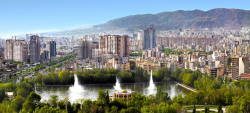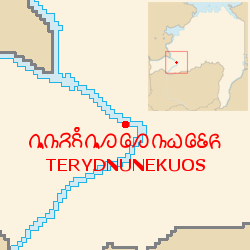Sonegio
Terydnunekuos
teriòtnunekuos | |
|---|---|
 | |
| Etymology: Large city on the Ekuos | |
| Nickname(s): Palace City | |
 Location of the city in Barradiwa. | |
| Country | Barradiwa |
| First settled in | 2250 BCE |
| Government | |
| • Mayor | Gídsueká Mánísut |
| Area | |
| • City | 2,670 km2 (1,030 sq mi) |
| • Urban | 570 km2 (220 sq mi) |
| • Metro | 2,100 km2 (800 sq mi) |
| Population | |
| • City | 14,638,315 |
| • Density | 5,500/km2 (14,000/sq mi) |
| Website | www.t-ekuos.bd |
Terydnunekuos (pronunciation: /teɹidnunekwos/, Ekuostian: teriòtnunekuos, IPA: /t̪ery:d̪n̪un̪ekwʌs/), also known as Palace City (or Terydsonegíero), is the capital and largest city in Barradiwa. With a population of approximately 14.6 million, the city is (as of 2015) the 6th largest city in the world by measure of population in the city proper, the second largest city in Baredina (behind Bohur), and the largest country capital in the world (barring the city-state of Bosato).
The city—being where the Emperor of Barradiwa lives and operates—serves as the cultural, economic, and administrative center of Barradiwa. Despite being located in the region of Ekuostia which is governed from Rydkes, Palace City has historically acted as a sort of "over-capital" to Barradiwa as a whole, and the country's three regions and their capitals nominally serve under it.
The city is located on the Ekuos River, approximately 97km upstream from the Ekuos riverbend where the river sharply diverts southward. This location has helped the city foster and maintain wide regional influence, and has been crucial to its position in regional trade and commerce both historically and in modern times.
Due to the city's long and rich history, large size and population, and its importance in the global economy, it is a popular destination for both tourists and immigrants.
Etymology
The city's name, which was only adopted as its official name in 1808 (although the name had been used informally before then), literally means "large city on the Ekuos". This name was chosen to instill a more neutral, less arrogant view of the city, supplanting its old name (which is still a widely common nickname today), Palace City. The name Palace City comes from the fact that the city has numerous palaces in its old town center, reflecting the fact that every new dynasty taking control of Palace City (excepting the Kauzic dynasty that ruled the city from 1490-1548) built a palace in their name.